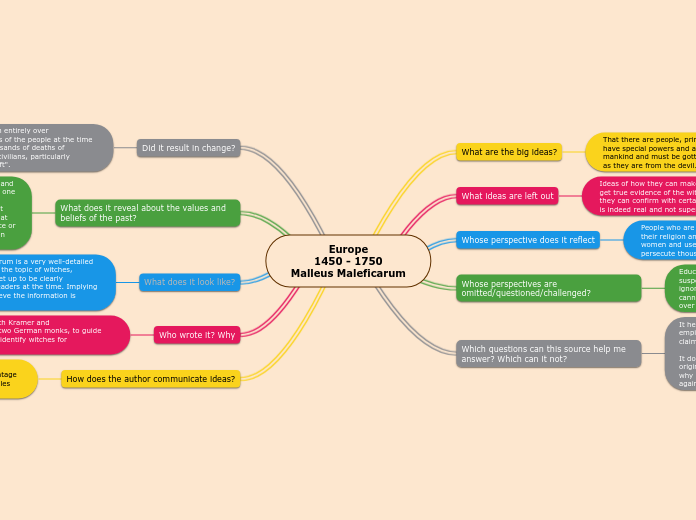Europe
1450 - 1750
Malleus Maleficarum
What are the big ideas?
That there are people, primarily women, who
have special powers and are a danger to all of
mankind and must be gotten rid of immediately
as they are from the devil.
What ideas are left out
Ideas of how they can make the trial fair,
get true evidence of the witchcraft and how
they can confirm with certainty that witchcraft
is indeed real and not superstition.
Whose perspective does it reflect
People who are blinded by their understanding of their religion and hold a deep bias against women and use deranged theories just to persecute thousands of women unjustifiably.
Whose perspectives are omitted/questioned/challenged?
Educated scholars' perspectives and primarily the suspected women's perspectives are completely ignored. The suspected and persecuted women cannot even defend themselves and are killed over superstition.
Which questions can this source help me answer? Which can it not?
It helps me understand the importance of
empirical evidence and proof when making a claim, as well as how vital removing bias is.
It does not help me understand where this original demonization of women stems from and why such an absurd idea would be created to use against thousands of women.
Did it result in change?
The writing had taken entirely over
the minds and actions of the people at the time
leading to many thousands of deaths of
most likely innocent civilians, particularly women, for "witchcraft".
What does it reveal about the values and beliefs of the past?
The impact of the text revealed how gullible and over-dramatic people were at the time when one insane idea took over the minds of millions, causing them to take life-changing actions. It even hints at how people thought of women at the time, where even without proper evidence or reasoning, they did not hesitate to kill women over an absurd superstition.
What does it look like?
The Malleus Maleficarum is a very well-detailed and lengthy book on the topic of witches, organized well and set up to be clearly understood by the readers at the time. Implying that the authors believe the information is critical.
Who wrote it? Why
Written by Heinrich Kramer and
James Sprenger, two German monks, to guide others on how to identify witches for prosecution.
How does the author communicate ideas?
The authors use well detailed paragraphs
to get their point across, while taking advantage
of an already existing superstition and peoples hostility and value of women at the time.
